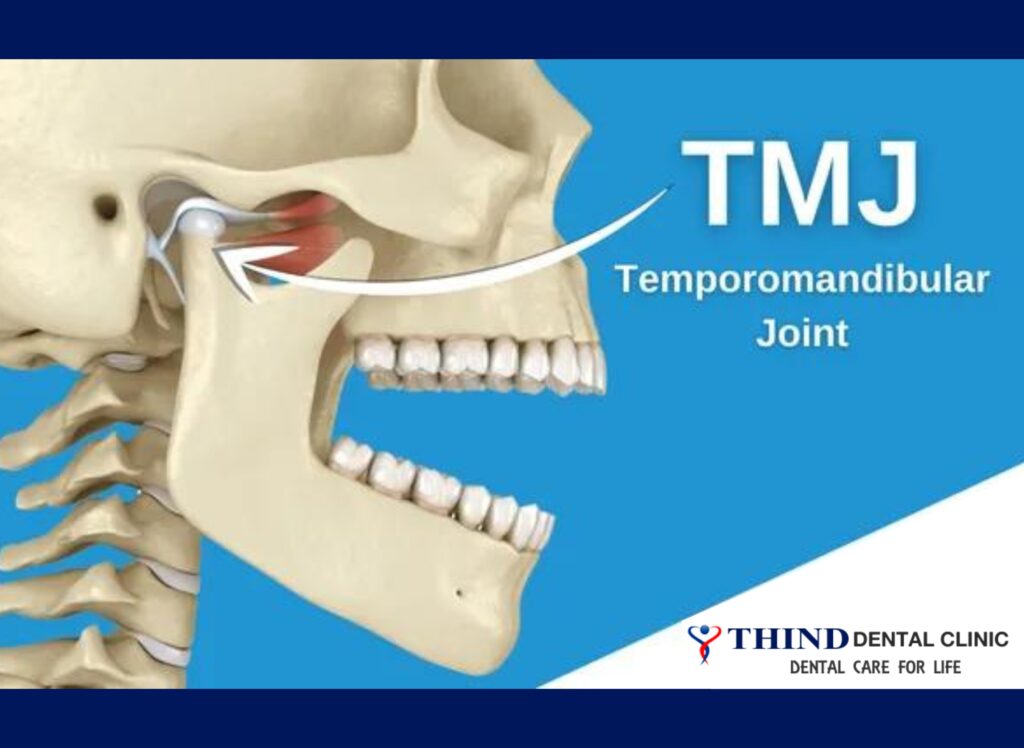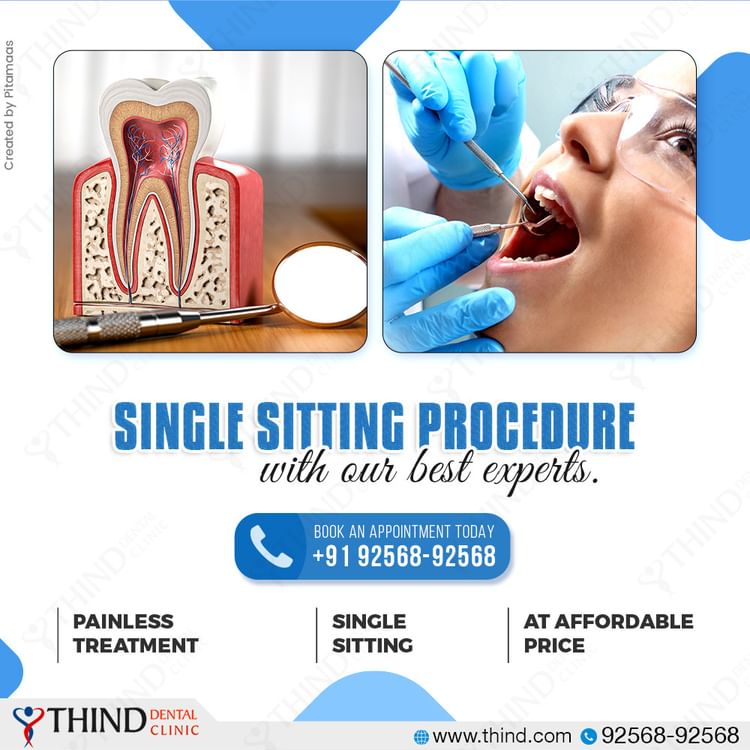The temporomandibular joint (TMJ) is a crucial component of the jaw, connecting the lower jawbone (mandible) to the skull’s temporal bone. This intricate joint plays a vital role in fundamental activities such as chewing, speaking, and yawning. However, when problems arise within the TMJ, it can lead to discomfort and dysfunction, collectively known as temporomandibular joint disorders (TMD). At Thind Dental Clinic in Ludhiana, we understand the impact of TMJ disorders on oral health and overall well-being, and we are committed to providing comprehensive care to address these issues.
Understanding TMJ Disorders:
1. Causes of TMJ Disorders:
Temporomandibular joint (TMJ) disorders can arise from a multitude of factors, each contributing to the dysfunction and discomfort experienced by individuals. One common cause of TMJ disorders is trauma or injury to the jaw joint or its surrounding structures. Accidents, sports injuries, or blows to the face can lead to misalignment or damage within the TMJ, resulting in pain and restricted movement. Additionally, bruxism, characterized by the habitual grinding or clenching of teeth, can exert excessive pressure on the TMJ, leading to inflammation and irritation of the joint. Furthermore, arthritis affecting the TMJ, whether it be osteoarthritis or rheumatoid arthritis, can cause degenerative changes within the joint, resulting in pain and stiffness. Malocclusion, or the misalignment of the teeth or jaw, can also contribute to TMJ disorders by disrupting the natural harmony of the bite, leading to strain and dysfunction within the joint.
2. Symptoms of TMJ Disorders:
Identifying the symptoms associated with temporomandibular joint (TMJ) disorders is paramount for prompt diagnosis and treatment. Individuals with TMJ disorders may experience a variety of symptoms that can affect their daily lives. Among the most common signs is jaw pain or tenderness, particularly noticeable during activities like chewing or speaking. Additionally, clicking, popping, or grating sounds may occur when moving the jaw, indicative of joint dysfunction. Some individuals may also notice a limited range of motion in the jaw, making it challenging to open or close their mouths fully. Headaches, earaches, or facial pain can also accompany TMJ disorders, further impacting overall comfort. Muscle stiffness or soreness in the jaw, neck, or shoulders may also be present, contributing to discomfort and tension. In severe cases, individuals may experience lockjaw, where the jaw becomes temporarily immobilized in an open or closed position, causing considerable distress and inconvenience.
3. Diagnosis of TMJ Disorders:
Diagnosing temporomandibular joint (TMJ) disorders requires a thorough assessment conducted by a qualified dental practitioner. The diagnostic process entails several key steps to accurately identify the underlying issues affecting the TMJ. Initially, the dentist will conduct a comprehensive review of the patient’s medical history, paying particular attention to any reported symptoms related to jaw discomfort, clicking sounds, or limited jaw movement. A detailed discussion with the patient about their symptoms and any relevant factors such as previous injuries or dental treatments is essential for proper diagnosis.
Following the medical history review, a physical examination of the jaw joint, surrounding muscles, and oral structures is conducted. This examination helps the dentist assess the range of motion of the jaw, identify any areas of tenderness or swelling, and evaluate the alignment of the bite. Palpation of the TMJ area may reveal signs of inflammation or muscle tension, providing valuable diagnostic insights.
In addition to the physical examination, dental imaging studies such as X-rays, CT scans, or MRI scans may be ordered to obtain detailed images of the TMJ structure and function. These imaging techniques allow the dentist to assess the joint’s alignment, detect any abnormalities or degenerative changes, and rule out other potential causes of the patient’s symptoms.
Treatment Options for TMJ Disorders:
1. Conservative Treatments:
In many cases, TMJ disorders can be effectively managed with conservative treatment measures, including:
- Lifestyle modifications to reduce stress and minimize jaw strain
- Jaw exercises and stretches to improve mobility and reduce muscle tension
- Using heat or cold packs can effectively reduce pain and inflammation associated with TMJ disorders.
- Prescription medications such as muscle relaxants or nonsteroidal anti-inflammatory drugs (NSAIDs) to relieve pain and discomfort
2. Dental Interventions:
Depending on the underlying cause of the TMJ disorder, dental interventions may be necessary, such as:
- Occlusal adjustments to correct bite problems and alleviate pressure on the TMJ
- Dental splints or mouthguards to protect the teeth from bruxism and stabilize the jaw joint
- Orthodontic treatment to address malocclusion and improve jaw alignment
3. Advanced Therapies:
For severe or refractory cases of TMJ disorders, advanced therapeutic options may be recommended, including:
- Trigger point injections to alleviate muscle pain and tension in the jaw
- Botox injections to temporarily paralyze overactive jaw muscles and reduce muscle spasms
- TMJ surgery to repair or replace damaged joint structures in complex cases
Comprehensive Care at Thind Dental Clinic:
As the best dental clinic in Ludhiana, we take a multidisciplinary approach to TMJ disorder management, combining expertise from various dental specialties to provide comprehensive care tailored to each patient’s unique needs. Our experienced dentists and specialists utilize state-of-the-art diagnostic tools and treatment modalities to diagnose and treat TMJ disorders effectively. We prioritize patient education and empowerment, ensuring that individuals understand their condition and treatment options to make informed decisions about their oral health.
In conclusion, understanding temporomandibular joint disorders is essential for recognizing the signs and symptoms early and seeking appropriate treatment. With a comprehensive approach to TMJ disorder management at Thind Dental Clinic in Ludhiana, patients can find relief from pain and dysfunction, restoring comfort and functionality to their daily lives. If you’re experiencing symptoms of TMJ disorders, don’t hesitate to schedule a consultation with us to explore your treatment options and take the first step towards a healthier, happier smile.
For additional information or to arrange an appointment with us
You can contact us at +91-92568-92568
or visit us at:
THIND DENTAL CLINIC
11-12-13-14 H.I.G Market, Opposite Water Tank, Ludhiana, Punjab 141010.
Also Read:
Single Sitting Procedure: Painless and Affordable Dental Care at Thind Dental Clinic
Dental Care for Children: Expert Tips for Parents on Caring for Your Child’s Teeth
Restoring Smiles: Painless Root Canal Treatment in Ludhiana
Transform Your Smile with Braces Treatment at Thind Dental Clinic

 Timings
Timings


